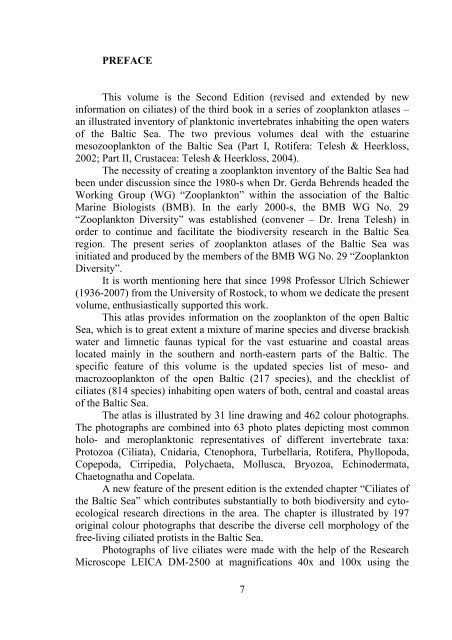Zooplankton of the open Baltic: Extended Atlas - IOW
Zooplankton of the open Baltic: Extended Atlas - IOW
Zooplankton of the open Baltic: Extended Atlas - IOW
Create successful ePaper yourself
Turn your PDF publications into a flip-book with our unique Google optimized e-Paper software.
PREFACE<br />
This volume is <strong>the</strong> Second Edition (revised and extended by new<br />
information on ciliates) <strong>of</strong> <strong>the</strong> third book in a series <strong>of</strong> zooplankton atlases –<br />
an illustrated inventory <strong>of</strong> planktonic invertebrates inhabiting <strong>the</strong> <strong>open</strong> waters<br />
<strong>of</strong> <strong>the</strong> <strong>Baltic</strong> Sea. The two previous volumes deal with <strong>the</strong> estuarine<br />
mesozooplankton <strong>of</strong> <strong>the</strong> <strong>Baltic</strong> Sea (Part I, Rotifera: Telesh & Heerkloss,<br />
2002; Part II, Crustacea: Telesh & Heerkloss, 2004).<br />
The necessity <strong>of</strong> creating a zooplankton inventory <strong>of</strong> <strong>the</strong> <strong>Baltic</strong> Sea had<br />
been under discussion since <strong>the</strong> 1980-s when Dr. Gerda Behrends headed <strong>the</strong><br />
Working Group (WG) “<strong>Zooplankton</strong>” within <strong>the</strong> association <strong>of</strong> <strong>the</strong> <strong>Baltic</strong><br />
Marine Biologists (BMB). In <strong>the</strong> early 2000-s, <strong>the</strong> BMB WG No. 29<br />
“<strong>Zooplankton</strong> Diversity” was established (convener – Dr. Irena Telesh) in<br />
order to continue and facilitate <strong>the</strong> biodiversity research in <strong>the</strong> <strong>Baltic</strong> Sea<br />
region. The present series <strong>of</strong> zooplankton atlases <strong>of</strong> <strong>the</strong> <strong>Baltic</strong> Sea was<br />
initiated and produced by <strong>the</strong> members <strong>of</strong> <strong>the</strong> BMB WG No. 29 “<strong>Zooplankton</strong><br />
Diversity”.<br />
It is worth mentioning here that since 1998 Pr<strong>of</strong>essor Ulrich Schiewer<br />
(1936-2007) from <strong>the</strong> University <strong>of</strong> Rostock, to whom we dedicate <strong>the</strong> present<br />
volume, enthusiastically supported this work.<br />
This atlas provides information on <strong>the</strong> zooplankton <strong>of</strong> <strong>the</strong> <strong>open</strong> <strong>Baltic</strong><br />
Sea, which is to great extent a mixture <strong>of</strong> marine species and diverse brackish<br />
water and limnetic faunas typical for <strong>the</strong> vast estuarine and coastal areas<br />
located mainly in <strong>the</strong> sou<strong>the</strong>rn and north-eastern parts <strong>of</strong> <strong>the</strong> <strong>Baltic</strong>. The<br />
specific feature <strong>of</strong> this volume is <strong>the</strong> updated species list <strong>of</strong> meso- and<br />
macrozooplankton <strong>of</strong> <strong>the</strong> <strong>open</strong> <strong>Baltic</strong> (217 species), and <strong>the</strong> checklist <strong>of</strong><br />
ciliates (814 species) inhabiting <strong>open</strong> waters <strong>of</strong> both, central and coastal areas<br />
<strong>of</strong> <strong>the</strong> <strong>Baltic</strong> Sea.<br />
The atlas is illustrated by 31 line drawing and 462 colour photographs.<br />
The photographs are combined into 63 photo plates depicting most common<br />
holo- and meroplanktonic representatives <strong>of</strong> different invertebrate taxa:<br />
Protozoa (Ciliata), Cnidaria, Ctenophora, Turbellaria, Rotifera, Phyllopoda,<br />
Copepoda, Cirripedia, Polychaeta, Mollusca, Bryozoa, Echinodermata,<br />
Chaetognatha and Copelata.<br />
A new feature <strong>of</strong> <strong>the</strong> present edition is <strong>the</strong> extended chapter “Ciliates <strong>of</strong><br />
<strong>the</strong> <strong>Baltic</strong> Sea” which contributes substantially to both biodiversity and cytoecological<br />
research directions in <strong>the</strong> area. The chapter is illustrated by 197<br />
original colour photographs that describe <strong>the</strong> diverse cell morphology <strong>of</strong> <strong>the</strong><br />
free-living ciliated protists in <strong>the</strong> <strong>Baltic</strong> Sea.<br />
Photographs <strong>of</strong> live ciliates were made with <strong>the</strong> help <strong>of</strong> <strong>the</strong> Research<br />
Microscope LEICA DM-2500 at magnifications 40x and 100x using <strong>the</strong><br />
7

















